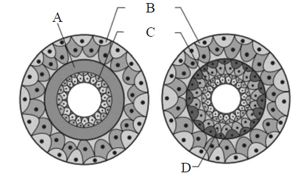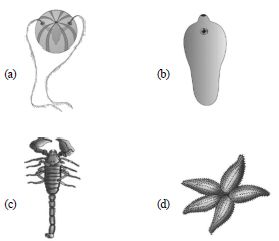The combination of a true coelom and repeating body segmentation allows the annelids (unlike the anatomically simpler worms) to do which of the following?
Attain complex body shapes and thus locomote more precisely.
Move through loose marine sediments.
Be hermaphroditic.
Inject paralytic poisons into their prey.
Correct Answer :
A. Attain complex body shapes and thus locomote more precisely.
The segmentation of the annelids allows for more complex coordinated movement.
Related Questions
The figure given below shows the germinal layers marked as A, B, C and D. Identify the label showing undifferentiated layer and its location?

A, Between B & C
B, Between A & C
C, Between C & D
D, Between A & B
Which of the following statement(s) is/are correct for class amphibia?
(i) Body is divisible into head and trunk.
(ii) Respiration is through gills only.
(iii) The heart is two chambered i.e. one auricle and one ventricle.
(iv) Fertilization is internal.
Only (i)
Only (iv)
(i), (ii) and (iii)
All of these
Which of the following pairs of animals are similar to each other pertaining to the feature stated against them?
Pteropus and Ornithorhyncus - Viviparity
Garden lizard and crocodile - Three chambered heart
Ascaris and Ancylostoma - Metameric segmentation
Sea horse and flying fish - Cold blooded (poikilothermal)
Match the phylum given in column - I with their example given in column - II and choose the correct option.
| Column -I | Column- II |
|---|---|
| (Phylum) | (Examples) |
| A. Echinodermata | I. Ascidia, Doliolum |
| B. Hemichordata | II. Asterias, Ophiura |
| C. Urochordata | III. Branchiostoma |
| D. Cephalochordata | IV. Balanoglossus, Saccoglossus |
A IV; B II; C I; D III
A II; B IV; C I; D III
A II; B IV; C III; D I
A II; B I; C IV; D III
Which of the following animal contains respiratory organs like, gills, book gills, book lungs or tracheal system?

Click to check answer
Click to check answer
Click to check answer
Click to check answer
A student brought home a strange animal which he found outside under a rock. It had moist skin, a complete digestive tract, a ventral nerve cord, and had gone through torsion. Identify the phylum of the animal.
Porifera
Annelida
Mollusca
Echinodermata
Which of the following statement(s) is/are correct regarding class aves?
(i) The forelimbs are modified into wings and the hindlimbs generally have scales and are modified for walking, swimming or clasping the tree branches.
(ii) Heart is completely four-chambered.
(iii) They are warm- blooded (homoiothermous) animals i.e., they are able to maintain a constant body temperature.
(iv) They are oviparous and development is direct.
Both (i) and (iii)
Both (i) and (iv)
(i), (ii) and (iii)
All of these
The figure given below is the characteristic structure of the phylum in which animals are aquatic, free swimming or sessile, mostly marine, radially symmetrical. Identify the phylum and correct function of the structure.

Ctenophora; Emission of light.
Porifera; Feeding, respiration and excretion.
Cnidarian; Anchorage, Defense and food capturing
Mollusca; Locomotion, transport of food and respiration.
Which of the follwoing statement(s) is/are correct?
(i) Organ systems in different group of animals show various patterns of complexities.
(ii) The digestive system in platyhelminthes has only a single opening to the outside of the body that serve as both mouth and anus, and is hence called complete.
(iii) In open type of circulatory system, the blood is pumped out of the heart and the cells and tissues are directly bathed in it.
(iv) In closed type, the blood is circulated through a series of vessels of varying diameters (arteries, veins and capillaries).
Only (i)
Both (ii) and (iii)
(i), (iii) and (iv)
All of these
Refer the figures A, B, C and D given below. Which of the following options shows the correct name of the animals shown by the figures A, B, C and D ?

A – Locust, B – Scorpion, C – Prawn, D – Pila
A – Locust, B – Prawn, C – Scorpion, D – Pila
A – Locust, B – Scorpion, C – Prawn, D – Snail
A – Butterfly, B – Scorpion, C – Prawn, D – Pila
The organisms attached to the substratum generally possess
one single opening to the digestive canal.
cilia on the surface to create water current.
radial symmetry.
asymmetrical body.
Match the types of animals given in column I with their examples given in column II and choose the correct option.
| Column -I | Column -II |
|---|---|
| (Types of animals) | (Examples) |
| A. Limbless reptiles | I. Elephant |
| B. Jawless vertebrates | II. Lamprey |
| C. Flightless bird | III. Ichthyophis |
| D. Largest | IV. Ostrich terrestrial animal |
| E. Limbless amphibia | V. Cobra |
A II; B V; C IV; D I; E III
A V; B II; C IV; D I; E III
A V; B II; C I; D IV; E III
A V; B IV; C II; D I; E III
Which of the following possesses electric organs and belongs to class chondrichthyes?
Torpedo
Petromyzon
Trygon
Exocoetus
Few cnidarians like corals have a skeleton composed of
calcium hydroxide
calcium sulphate
calcium carbonate
sodium bicarbonate
The transition from aquatic to terrestrial lifestyles required many adaptations in the vertebrate lineage. Which of the following is not one of those adaptations ?
Switch from gill respiration to air-breathing lungs.
Improvements in water resistance of skin.
Alteration in mode of locomotion.
Development of feathers for insulation.
The following statement are associated with the occurrence of notochord. Identify the incorrect statement.
It is present only in larval tail in ascidians.
It is replaced by a vertebral column in adult frog.
It is absent throughout the life in humans from the very beginning.
It is present throughout life in Amphioxus.
Which of the following is not a characteristic of phylum echinodermata ?
They have a water vascular system.
They have an internal skeleton.
They are protostomes.
They have bilateral symmetry at larval stage.
Match the terms/feature given in column I with their examples given in column II and select the correct match from the option given below.
| Column-I | Column-II |
|---|---|
| (Term/Feature) | (Examples) |
| A. Gregarious pest | i. Hirudinaria |
| B. Vector | ii. Planaria |
| C. Oviparous with | iii. Sepia indirect development |
| D. Metameres | iv. Aedes |
| E. High regeneration | v. Locust capacity |
A - i, B - ii, C - iii, D - iv, E - v
A - iii, B - v, C - ii, D - iv, E - i
A - iii, B - i, C - v, D - ii, E - iv
A - v, B - iv, C - iii, D - i, E - ii
Meandrina (brain coral) belongs to phylum
porifera
coelenterata
ctenophora
platyhelminthes
Which of the following is a living fossil?
Balanoglossus
Echinus
Ancylostoma
Limulus
Which of the following class is being correctly described by given statements (i - iv)?
(i) All living members of this class are ectoparasites on some fishes.
(ii) They have a sucking and circular mouth without jaws.
(iii) Circulation is of closed type.
(iv) They are marine but migrate for spawning to fresh water. After spawing, within a few days they die.
Cyclostomata
Chondrichthyes
Osteichthyes
Amphibia
Which of the following phylum is being described by the given statements?
(i) These are primitive multicellular animals and have cellular level of organization.
(ii) Digestion is intracellular.
(iii) They have a water transport or canal system.
(iv) They reproduce asexually by fragmentation and sexually by formation of gametes.
Porifera
Ctenophora
Coelenterata
Platyhelminthes
Which of the following pairs of animals comprises jawless fishes?
Mackerals and rohu
Lampreys and hag fishes
Guppies and hag fishes
Lampreys and eels
In which of the phylum, excretory organ like proboscis gland is present?
Hemichordata
Chordata
Echinodermata
Annelida
Which of the following is a connecting link between invertebrates and non-invertebrates?
Sphenodon
Balanoglossus
Tadpole larva
Crocodile
Which of the following group of animals reproduces only by sexual means?
Ctenophora
Cnidaria
Porifera
Protozoa
In phylum arthropoda, excretion takes place through
nephridia
flame cells
malphigian tubules
gills
Polyp phase is absent in
Hydra
Aurelia
Physalia
Obelia
When any plane passing through the central axis of the body divides the organism into two identical halves, the organism is called ___________.
radially symmetrical
bilaterally symmetrical
asymmetrical
metamerically segmented
Refer the following statement and answer the question. 'Name of X is derived from stinging capsules. It exhibits metagenesis containing two body forms in which sessile and cylindrical form is called Y and umbrella shaped and free swimming is called Z. Identify X, Y, and Z.
X - Coelenterate, Y - Polyp, Z - Medusa
X - Cnidarian, Y - Medusa, Z - Polyp
X - Ctenophora, Y - Radula, Z - Hypostome
X - Porifera, Y - Osculum, Z - Radula
